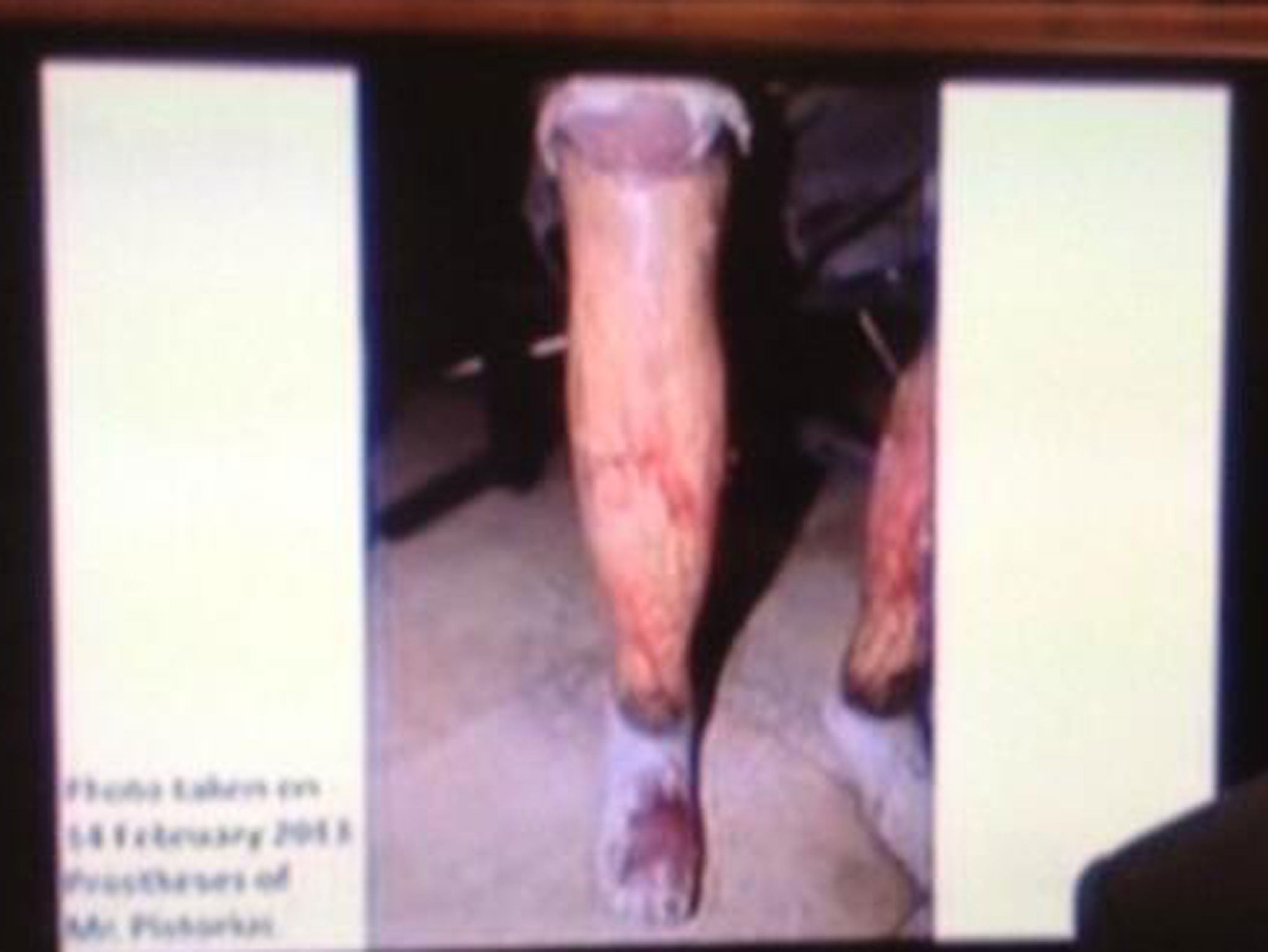Oscar Pistorius trial: Paralympian's firearms test shows athlete knew shooting at unseen target was 'illegal'
Photographs of athlete taken after fatal shooting shown in court as murder trial continues

Your support helps us to tell the story
From reproductive rights to climate change to Big Tech, The Independent is on the ground when the story is developing. Whether it's investigating the financials of Elon Musk's pro-Trump PAC or producing our latest documentary, 'The A Word', which shines a light on the American women fighting for reproductive rights, we know how important it is to parse out the facts from the messaging.
At such a critical moment in US history, we need reporters on the ground. Your donation allows us to keep sending journalists to speak to both sides of the story.
The Independent is trusted by Americans across the entire political spectrum. And unlike many other quality news outlets, we choose not to lock Americans out of our reporting and analysis with paywalls. We believe quality journalism should be available to everyone, paid for by those who can afford it.
Your support makes all the difference.Oscar Pistorius knew he was breaking the law when he fired at girlfriend Reeva Steenkamp through a locked toilet door, his murder trial heard.
Sean Patrick Rens, a firearms training and licensing officer, told the court the athlete's firearms competency test showed he was aware that firing at an unseen target was illegal.
Pistorius wrote in his competency questionnaire you must "always know your target and what lies behind" before firing a weapon and scored top marks in the test.
To the question: "You’re at home alone, you see men jump over the wall, it’s late at night - can you shoot?", Pistorius answered no.
He also stated that, before you are entitled to open fire, any attack must be "against you, must be unlawful, it must be against the person."
Mr Rens told Pretoria's High Court he knew of Pistorius' "great love and enthusiasm" for guns. The pair met at a shooting range in 2012.
He said the athlete had asked him to provide him with a revolver and was seeking to collect other guns.
He showed the court an invoice for a S&W 500 revolver, an LM6 assault rifle, two shotguns and a 38 Special revolver. The order was cancelled because he did not have a collector licence.
In a separate incident, he described how Pistorius told him he was alerted by a noise at his Pretoria home and went into "full combat mode" by drawing his gun and checking rooms looking for a possible intruder.
"He went into what we call 'code red' or combat mode," Mr Rens told the court. "When he came to the source of the noise, it was the laundry or something."
Pistorius tweeted about the incident in November 2012: "Nothing like getting home to hear the washing machine on and thinking its an intruder to go into full combat recon mode into the pantry!"
His defence counsel, Barry Roux, asked Mr Rens if Pistorius, with his level of training, would have been able to fire, from two or three metres away, through a door at the height where the head and central body would be. The shots in the bathroom door are all only around 90 centimetres from the ground.
He answered: "Absolutely, my lady".
Later, court heard from police crime scene photographer Bennie van Staden, who arrived at the house at approximately 04:50 am on Valentine's Day last year and took photographs of Pistorius before he was arrested and girlfriend Reeva Steenkamp.
One of the photographs appeared to show a blood mark above Pistorius’s bed.
The athlete’s version of events is that after breaking down the locked toilet door and finding Ms Steenkamp on the floor, he carried her body downstairs, at no point returning to the bedroom.
The inclusion of the image on the evidence reel suggests the state will try to use it to counter Pistorius’s story of what happened in his house on the night he shot his girlfriend.
Another photograph from the Paralympian's bedroom showed boxes of 'testis compositum'- a testosterone booster and sexual performance enhancer- as well as syringes, needles, condoms and lubricant.
Mr Van Staden also photographed the cricket bat used by the athlete to smash down the locked toilet door, the toilet bowl and the bathroom floor.
Earlier, Pistorius greeted Ms Steenkamp's mother, June Steenkamp, as he walked into court. She nodded and appeared to acknowledge him. Pistorius's sister, Aimee, also approached her, speaking to her for several minutes.
Mrs Steenkamp had spoken of her disappointment after Pistorius failed to "look her in the eye" at the start of his murder trial earlier this month. She had told reporters she was prepared to forgive the athlete despite losing her daughter, but was left shaken after Pistorius ignored her presence.
Mrs Steenkamp left the court before Mr Van Staden described her daughter's injuries. The television screens next to Pistorius were turned off after the athlete threw up last week after a graphic photograph of Ms Steenkamp's body was displayed by mistake.
The 29-year old model and law graduate was shot in the right hip, the elbow, and the right temple from a 9mm pistol carrying bullets designed to "penetrate and then mushroom" on impact, causing extensive damage on her body.
At the start of his murder trial, Pistorius pleaded not guilty of murdering Ms Steenkamp, claiming he shot her in a case of mistaken identity thinking she was an intruder.
Prosecutors argue he intentionally shot and killed his girlfriend following a domestic dispute. If convicted of murder he will almost certainly receive a life sentence, with a minimum term of 25 years.
The case continues.